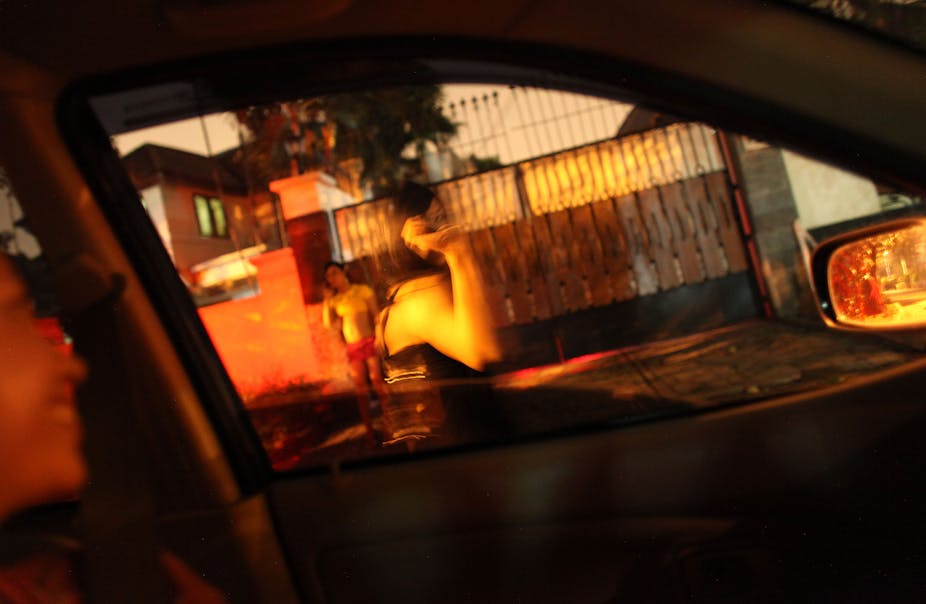A transgender woman with heavy makeup, a red wig and dressed in pink is chased by her pimp’s henchmen. A young woman hides her in her house.
So begins the TV drama, a story of repentance of a transgender person. In a supposedly happy ending, the transgender woman “returns” to being a man and marries the young woman.
To celebrate the Islamic holy month Ramadan and the Eid Fitr, Indonesian television station RCTI recently ran the TV drama Insyafnya seorang waria, which loosely translates as “Realisation of a transgendered woman”.

The film has drawn criticism from LGBT rights organisations in Indonesia for its misrepresentation of transgender people. Some members of the LGBT group protested through the Indonesian Broadcasting Commission, a government body that oversees implementation of broadcasting law in Indonesia. They have yet to receive feedback from the commission or the television station.
The film has a religious theme that is currently popular on various television channels in Indonesia. Since the fall of Indonesian dictator Suharto, who clamped down on any political dissent, political Islam has undergone a revival. With this, religious themes have become more common in popular culture.
Transgender people in the media
A compound from wanita (woman) and pria (man), waria is an Indonesian term for transgender people. They have always been visible in the nation’s media. Films with waria characters abound. Waria characters are also often presented in films, soap operas, comedies, infotainment and talk shows.
Waria are often portrayed in a scornful manner. The media often make fun of and bully waria characters, using them as a laughing stock. Further, media portrayals of transgender people in Indonesia often start from the assumption that it’s a sin to be a trans. The film Insyafnya seorang waria is a blatant example of this.
The often over-the-top portrayals of waria depict transgender people in a negative light. In one of the film’s scenes, after “transforming” into a masculine heterosexual man the lead actor says: “It’s so hard to be good.” This statement implies a past as a waria is something bad, that being a waria is wrong.
Commodification of religious discourse
The use of the word insyaf, which means “to realise”, in the film refers to someone being aware of his or her mistake and trying to fix it. Another word that is often used in religious-themed cinema is tobat, meaning “to repent”. To realise (one’s mistake) or to repent is to become religious, usually by being a pupil of a religious teacher who would guide them to the right path.
In Insyaf, the film’s lead changes the way she dresses into Islamic masculine clothes. She “realises” her mistake and “transforms” herself to be a “normal” heterosexual man.
In Insyaf, the past is depicted as a dark side to be forgotten. As the transgendered woman becomes a heterosexual man, she becomes a he. As if one’s pronoun is a choice.
As a man, he should marry a woman as a manifestation of the ideal norm for masculinity. The film ends with a wedding ceremony. Insyaf’s narrative is an effort to reproduce and preserve the heteronormativity ideology in Indonesia’s society.
The right and normal sexuality is heterosexual within marriage. Anything outside of that is considered perverse and not normal.
In this context, the media become part of surveillance practices – borrowing Foucault’s term – to discipline individuals’ sexuality. Through films, soap operas, infotainment and others the media become part of the regime of truth. It disseminates the discourse on transgender identity as something that defies social and religious norms. With films such as Insyaf, the media play a role in defining the boundaries of accepted sexuality within the society.
To do this, the film deploys religious discourse, especially Islam, to affirm moral norms on sexuality. Sexuality becomes a battleground for power in order to control social order. Religion is used to set up rules that dictate which sexual practises are acceptable. The use of religious discourse through the media is a manifestation of the commodification of religion in contemporary Indonesia.
Misrepresentation harms transgender people
Media misrepresentation of transgendered people can influence people’s perceptions and attitudes. Transgendered people in Indonesia face violence, stigma and discrimination on a daily basis. There have been numerous reports of deaths and assaults on transgender women by officers of the state and the public in general.

In 2008, the debate about waria representation in the media surfaced when the broadcasting commission prohibited the media from using campy waria characters. However, they did this more to “protect” children and prevent them from imitating waria. Indonesian broadcasting law prohibits programs that portray minority groups and people with disabilities in a negative light.
Globally, there have been breakthroughs in media representation of transgender people. In the US, TV series such as Orange Is the New Black and Glee have featured transgender people as not mere caricatures but rounded complex characters. Insyaf and the lack of action from the broadcasting commission show Indonesia still has a long way to go.

